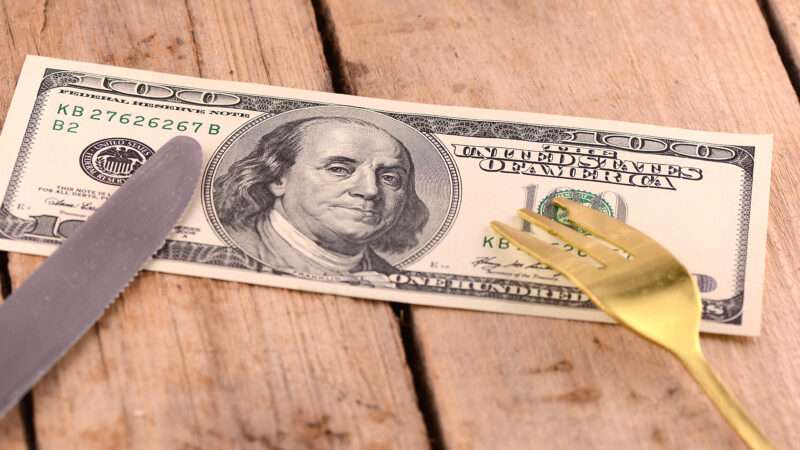
Diners have returned to eating out at pre-pandemic levels. But many restaurant owners themselves—still feeling the lingering effects of the pandemic and government-ordered closures—are demanding another round of federal support for their industry.
Last week, the Democrat-controlled House passed the Restaurant Revitalization Fund Replenishment Act on a mostly party-line 223–203 vote. The bill would spend another $42 billion on grants to cover the pandemic-era losses of restaurants, bars, and other hospitality businesses.
The federal government's Restaurant Revitalization Fund was created by the American Rescue Plan legislation that passed in March 2021. Three months later, it had already spent $28 billion in grants for restaurants and bars to make up for lost income during the pandemic. By June 2021, some 100,000 applicants had been approved for grants averaging $283,000, according to data from the Small Business Administration (SBA), which administers the program.
The SBA had received a total of 278,304 grant applications from restaurants and bars asking for a combined $72 billion in COVID relief grants. Members of the restaurant industry argue another round of funding is necessary to get money to those who missed out on the first handout.
A survey conducted by the Independent Restaurant Coalition (IRC) found that half of restaurants that had not received a grant from the SBA predicted they would close within the next six months. About 20 percent of restaurateurs who did receive an SBA relief grant said they'd close in six months.
"After two years of missed rent, supplier, and utility payments, navigating astronomical food costs, and multiple COVID-19 surges that brought businesses to a halt, independent restaurants and bars are out of time, options and money," said Erika Polmar, Executive Director of the Independent Restaurant Coalition (IRC). "There is only one solution to this crisis: provide these businesses the financial support they need before it's too late."
The apocalyptic tone is contrasted with other data points showing a restaurant industry that's steadily rebounding from the dark days of COVID-19.
Reservation app OpenTable's latest State of the Industry numbers shows that close to 95 percent of restaurants open in 2019 are back to accepting reservations. The number of people making reservations has also returned to 2019 levels.
Restaurant industry employment has been slower to rebound, but the trend is still upward.
Preliminary data from the Bureau of Labor Statistics (BLS) shows that some 11 million people were working in bars and restaurants nationwide in March 2022—about 5 percent below the number of people working in the industry in March 2019. BLS data also shows that as of the third quarter of 2021, the total number of restaurants had surpassed pre-pandemic levels.
That tracks with the surprise finding that, in general, there are more small businesses open today than existed before the pandemic.
Restaurants, bars, and other entertainment and hospitality businesses bore the brunt of government mandates and restrictions throughout the pandemic. In many states, they were ordered to close their dining rooms for months at a time.
When they were allowed to reopen, it was often at significantly reduced capacity—a real imposition for a tight margin business. Vaccine and mask mandates kept some customers away long after the last vestiges of lockdowns had disappeared.
One could argue that these government impositions entitle affected businesses to compensation.
"If the government shuts down only certain businesses on the grounds that they're areas where the pandemic can be spread more quickly, that's an action that the bar owner then is taking on behalf of the public," said Oliver Dunford, an attorney with the Pacific Legal Foundation to Reason back in July 2020. "Arguably the public should have to pay for it."
The trouble with the restaurant relief bill moving through Congress is that it would compensate businesses for lost revenue regardless of whether those losses were a result of government mandates or a voluntary unwillingness among customers to dine out. The proposal is also coming at a time when almost no pandemic restrictions are still in effect anywhere in the country.
Proponents of additional relief funding certainly aren't too hung up on whether aid covers government-imposed losses during the pandemic or just helps out restaurants in general.
"The Restaurant Revitalization Fund was designed to help restaurants deal with the consequences of the COVID-19 pandemic as well as challenges to the supply chain and workforce," said Rep. Earl Blumenauer (D–Ore.), the author of the Restaurant Revitalization Fund Replenishment Act, last week.
The IRC's Polmar likewise cites not just COVID-19 but also rising prices and "consumer hesitancy" as justification for more government aid to restaurants.
The argument for bailing out restaurants is thus morphing from a need to save the industry during the pandemic to a desire to relieve it from persistent challenges that have less and less to do with COVID-19.
That's hard to justify when the industry itself is on a steady track toward recovery, and federal spending is driving inflation to record levels.
The post The Restaurant Industry Doesn't Need Another Bailout appeared first on Reason.com.







